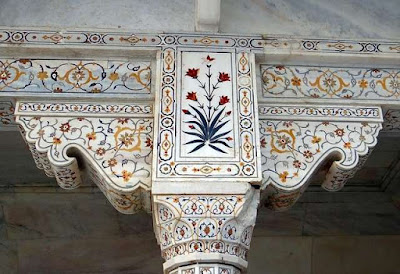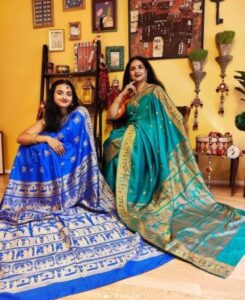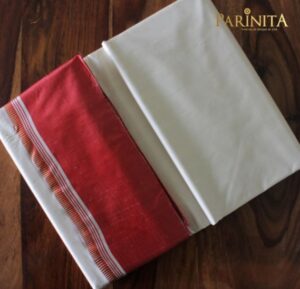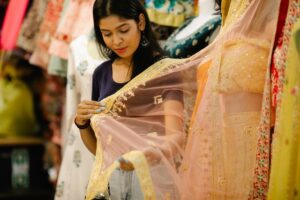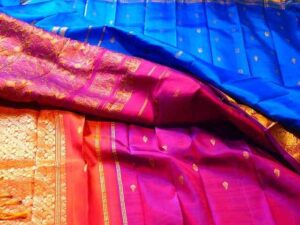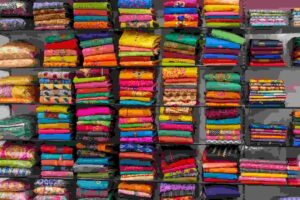Banarasi saree, the finest handcrafted fabric, is named after its origin city, Benaras(present-day Varanasi). From ancient times, Benaras was a large textile center of silk weaving. This oldest living city of India is considered holy among Hindus. Banarasi Saree made of fine silk thread with has many intricate and complex designs woven into that make the six yards stunning. In Varanasi, weavers still use hand-weaving techniques to create intricate designs with gold and silver Zaris to make the gorgeous Banarasi sarees.
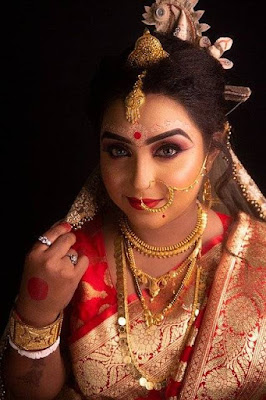 |
| Bridal Banarasi |
Benarasi saree is most sought after among the Indian brides, and their shopping is incomplete without it. This saree is a must for Bengali brides. Not only that, women from all religions and social status love to drape Benarasi on important occasions like weddings.
The Story Of Banarasi Sarees
Banarasi has found mentions in the legendary texts of the Mahabharata and Buddhist scriptures. It was introduced to India by the Mughal Empire. Hence, the intricate weaving and designs Of Benarasi are Mughals inspired.
Mainly Islamic motifs such as florals and foliate motifs, a string of leaves, and jali work are used in the saree. These opulent and rich embroideries, made by gold and silver threads, make the saree quite heavy.
The brocade weaving requires remarkable skill and knowledge. The time and labor increase with the complexity in designs and patterns. The weaving of a sari can take from 15 days to a month and sometimes up to six months to complete. Not surprisingly, The original Benarasi weaves and brocades are quite expensive.
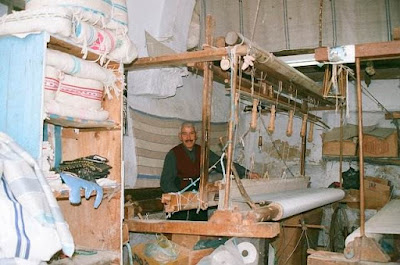 |
| Banarasi Handloom |
The fifth generation of weavers is preparing these sarees in Benaras. They mostly belong to the Muslim weaving community. Generally, three weavers work together to produce a saree. One weaves the silk, the second one engages the bundle of silk, which creates the power ring, and the third one assists in border designing. The designs are drawn previously on graph paper. Making the Banarasi saree requires teamwork.
There is two weaving technique for Benarasi – Kadhua and Fekuan. Kadhuan is a pure handloom produced only in the Varanasi region. These intricate designs cannot be imitated on a power loom and are possible only on handmade sarees. Here each motif is individually woven by the weaver. This laborious and time-intensive technique is the epitome of handloom brocade weaving in India. It requires extraordinary handiwork and finesse. It takes a labor of at least three persons for 3-4 months to complete a piece of Kadhuan weaved Banarasi saree. One person can weave a plain saree with the Fekuan technique.
Types Of Banarasi Saree
There are four main fabrics used for Banarasi sari, pure silk (Katan silk), Organza (Kora), Georgette, and Shattir. Of these, the pure silk variety is the most noted and preferred for bridal wear.
Various types of designs are made on these gorgeous fabrics. The main Banarasi designs are Jangla, Tanchoi, Vaskat, Cutwork, Tissue, and Butidar.
 |
| Shop Here : Pure Katan Silk Banarasi |
Banarasi Sarees in Katan silk with Buti/floral motifs are quite famous. They are usually made without zari borders but with the softest and heaviest silk. Butis or scattered leaf/ floral motifs are made in Resham or zari or the Minakari designs.
 |
| Shop Here : Organza Banarasi |
Banarasi Organza saris are admired for their all-weather appeal and elegant look. They are also known as Kora silk Banarasis.
 |
| Shop Here: Georgette Banarasi |
Banarasi Georgettes is a blissful blend of traditional and contemporary ethnic fashion and have also gained prominence. They usually have Resham work/ weaving.
 |
| Shop Here: Tussar Banarasi |
Cut-work, Tanchoi is a self-design sort of weave with no extra yarn on the back or front. Jamawar or Jamewar is mostly seen in shawls or as saris that come with a matching shawl.
The Fall Of Banarasi Handloom Weavers
An original Banarasi saree will cost a minimum of Rs. 8000. For them to be affordable nowadays for everyone, the threads have been replaced with colored gold and silver threads. Since the last few years, the patronage of authentic Banarasi is dying as cheaper imitations and power loom made sarees have taken their place.
Increasing quantities of fake Banarasi saris are flooding the market. These saris are mass-produced in China on massive looms and therefore retail at significantly low prices.
The handloom industry has incurred huge losses because of the unfair competition from mechanized units.
It is a sad state of affairs. Benares roads are full of former weavers who ply rickshaws, rowboats, run tea stalls, or doing whatever they can to fend off starvation and bankruptcy.
Since 2009, The government has started issuing the GI(Geographical Indication) certification for Banaras Brocades and Sarees. This government marker protects customers and the craftsmen. The GI protection demarcates original pieces from weavers in Uttar Pradesh against fakes from China, Surat, or others.
Look for the geographical indication (GI) tag to ensure you are buying authentic products.
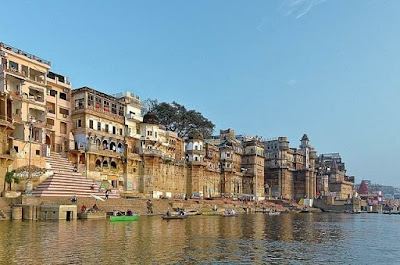 |
| Ghats Of Varanasi |
Today, Banarasi handloom textiles are one of the biggest cottage industries in the weaving sector in India. It has spread around several cities, towns around Varanasi in the state of Uttar Pradesh.
Varanasi, Mirzapur, Chandauli, Bhadohi, Jaunpur, and Azamgarh districts of Uttar Pradesh are the manufacturing hub of the saree.
 |
| Shop Here |
How To Identify A Genuine Banarasi Saree
While buying pure silk sarees, always insist on a certificate from the Silk Mark Organisation of India. Touch the fabric with your fingers. If it feels soft and lustrous, then the silk is authentic.
Pure Banarasi sarees are made from high-quality silk and real gold and silver zari and tend to be costly. There is a high possibility that cheap Saris are not the real Benarasi.
Check the reverse side for floats between the grids of warps and wefts, which only a handwoven saree will have. Machine woven saree does not have these.
Tips For Taking Care Of Banarasi Saree
Dry clean, and store the Banarasi in a muslin cloth. This muslin cloth allows the air to pass through the fabric but keeps away the moisture that can damage the saree. Change the folds from time to time to prevent tears in the saree.
